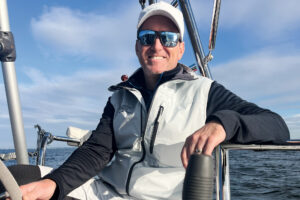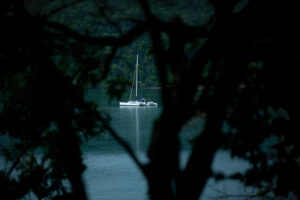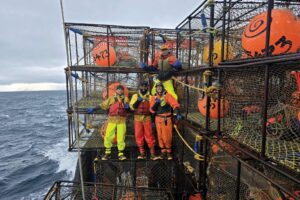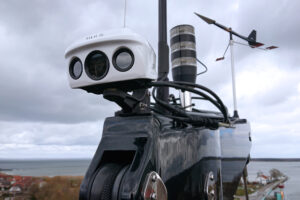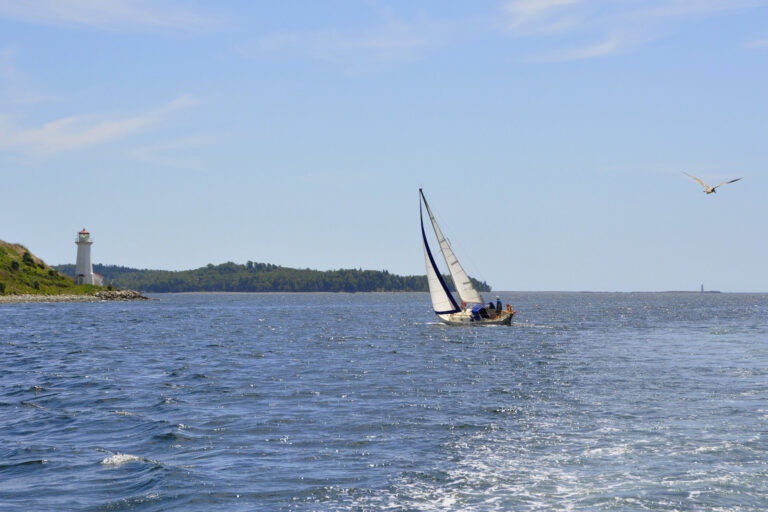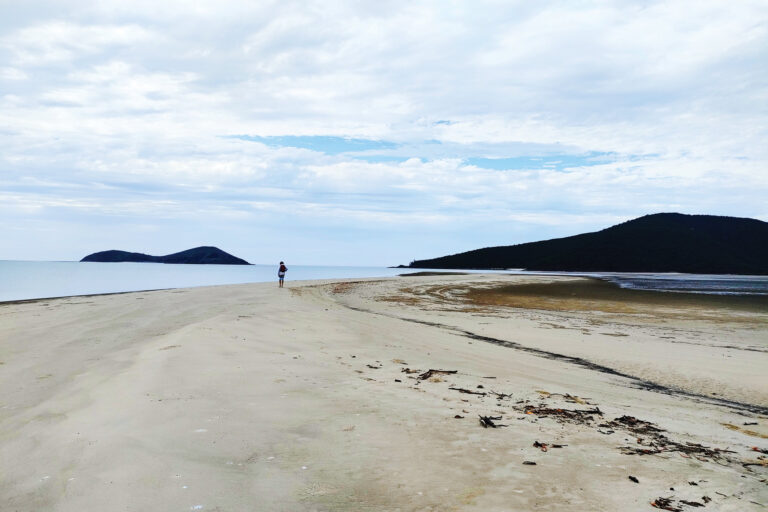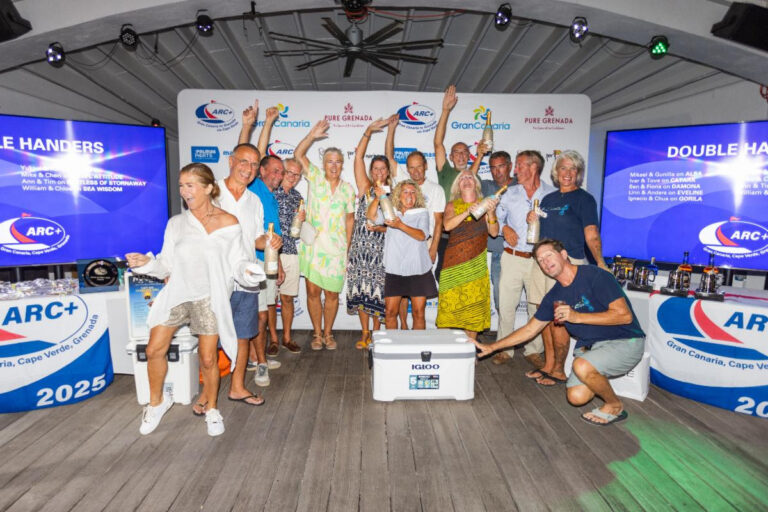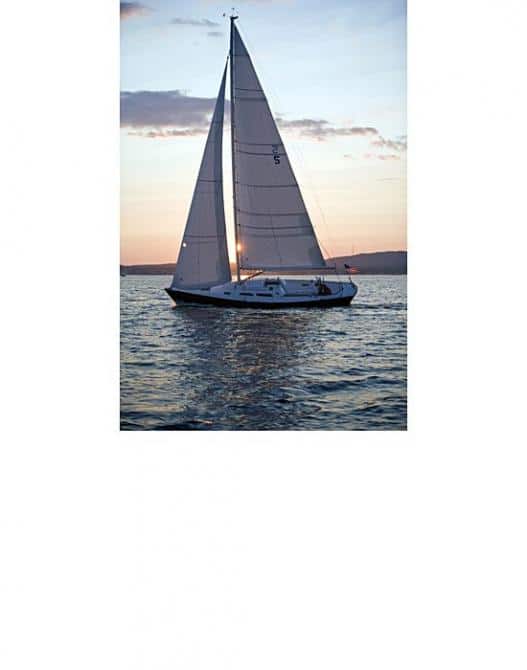
Sabre Spirit
The Oxford English Dictionary defines a yacht as “a light, fast-sailing ship . . . used for pleasure excursions.” The Sabre Spirit is a yacht. I found this boat not only easily handled and fast but also a sheer delight to sail; no wonder it won the Judges’ Choice Award in Cruising World’s 2008 Boat of the Year contest.
Jim Taylor-the designer of Sabres for the last 15 years-had noticed that most sailors in Marblehead, Massachusetts, would go out in the morning and return in the afternoon. He approached Sabre with the idea of producing a daysailer for those sailors. Sabre came back with the idea that it should be, instead, a “weekender.” When consulted, Sabre dealers suggested that the boat should have standing headroom below, which influenced the amount of freeboard and the height of the house, which in turn influenced the overall length needed for the boat to still look lovely on the water. And look lovely it does, with a low, sleek house, a nice spring to the sheer, and an ever-so-slightly spooned stem that complements its traditional transom perfectly. Taylor modestly attributes the boat’s DNA to Sabre founder and former chief designer Roger Hewson, who insisted that his boats first be lively, fast, and stylish. Furniture was then fitted to the hull shape, rather than the reverse, as is often found on modern cruisers.
Sabre built the boat I sailed with a one-piece E-glass hull, cored with Divinycell and coated with isophthalic gelcoat for blister resistance. The builder now uses Airex foam in the layup. Carbon-fiber stringers add to longitudinal stiffness. The deck is also cored with Divinycell and is bonded to the hull with 3M 5200 and through-bolted with stainless-steel fasteners. The lead keel is connected with stainless-steel bolts to a reinforced sump, and the balanced spade rudder is fiberglass bonded to a carbon stock.
Right after the first two boats were launched in the summer of 2007, the builder hosted an informal regatta in Marblehead for magazine editors. After several races upwind and down in winds that ranged from 5 knots to 12, I had a pretty good feel for the boat. The full-battened main was hung on an Antal track on a tall, carbon-fiber rig with double swept spreaders by Hall Spars, and it provided plenty of power to get the boat through the light slop, even though it sports only a self-tacking fractional jib-set on a Furlex furler that’s recessed below deck level in the anchor locker.
Helm feedback was excellent, and the boat stayed beautifully balanced as it heeled when the breeze was up, never demanding more than a couple of fingers on the 4-foot-diameter, teak-rimmed Edson wheel to keep it on track. The wheel’s size allows the helmsman to perch comfortably port or starboard on the teak-topped coaming with a good view of the jib. The traveler is aft of the cockpit, with controls just forward of the helmsman on both sides, next to the winches for the double-ended mainsheet. In the 10-foot-long cockpit are 6-foot seats, and the coamings outside them are high, with comfortable backrests. Large cubbyholes provide ample stowage for sheet tails. The seat lockers and a lazarette provide tons of storage. Halyards, jib sheet, and sail controls are led though Spinlock clutches to a winch on either side of the companionway.
Forward, the deck is uncluttered. Navtec rod rigging leads to outboard chainplates, worthwhile stainless-steel handrails sit on the house, and the jib leads to an athwartships track forward of the mast. Optional teak toerails gleam with varnish, and fold-down mooring cleats fore and aft stow sleekly; the midship cleats are fixed. Pulpits and stanchions fit into sockets and are removable, demonstrating how committed the builder is to aesthetics on the Spirit.
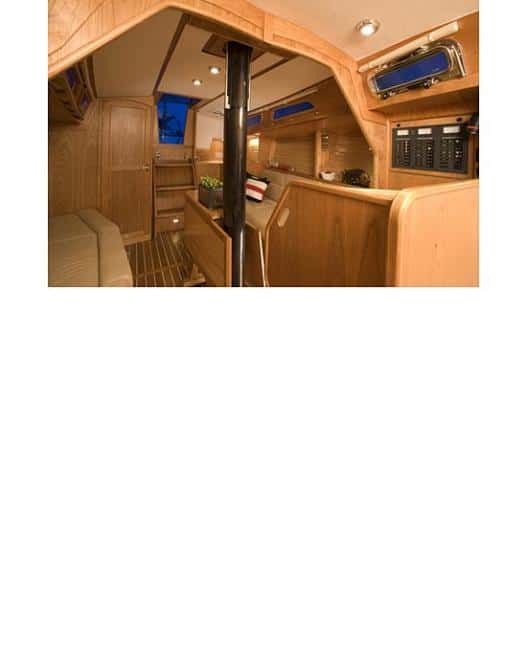
Below, a teak-and-holly sole contrasts with satin-varnished cherry woodwork. The view forward to the anchor locker bulkhead is almost uninterrupted, making the interior seem bigger than it really is. It’s well lit and ventilated by three opening Lewmar hatches, a pair of stainless-steel opening ports, and four large fixed ports. To starboard of the companionway is a white-gelcoated head and shower with standing headroom and a Quiet Flush electric toilet. To port, the galley features a Force 10 two-burner propane stove and oven, an icebox, and a smallish sink.
The companionway steps lift for access to the 27-horsepower Volvo that’s connected to a saildrive for quiet operation. Settee berths on either side form a cozy social area in the saloon, with shelves outboard, handrails above, and a centerline drop-leaf table in between. At the forward end of the port berth is a small nav desk. Taylor says that since most boats will be sailed in waters well-known to their skippers, he saw no need to put the nav station near the companionway; boats ranging farther afield, he says, will be equipped with an on-deck chart plotter. The half bulkhead forward of the nav table makes a convenient place to wedge a pillow for reading in the 7-foot-long V-berth. Opposite the nav table is a small hanging locker, with drawers underneath. The cabin house extends forward of the mast, which makes getting into the V-berth easier and-with an opening hatch in the middle-eliminates any closed-in feeling.
The boat performs its function so perfectly that after a day of sailing outside Marblehead’s harbor and loathe to start the engine, I sailed through the crowded mooring field, tacking this nimble little yacht with a flick of the wrist while the crew and designer did nothing but enjoy a chat. We sailed up to the dock, dropping the main as we coasted to a stop behind the boat’s sister ship-exactly the kind of thing Taylor had in mind when he first drew the lines for the Sabre Spirit.
Andrew Burton is a Cruising World associate editor.
Sabre Spirit
LOA 36′ 8″ (11.18 m.)
LWL 28′ 4″ (8.64 m.)
Beam 10′ 5″ (3.18 m.)
Draft (deep/shoal keel) 6′ 7″/4′ 11″ (2.01/1.51 m.)
Sail Area 668 sq. ft. (62.1 sq. m.)
Ballast (deep/shoal keel) 3,740/4,360 lb.
(1,700/1,978 kg.)
Displacement (deep/shoal keel) 9,300/9,920 lb.
(4,218/4,500 kg.)
Ballast/D (deep/shoal keel) .40/.44
D/L (deep/shoal keel) 183/195
SA/D (deep/shoal keel) 24.2/23.2
Water 30 gal. (114 l.)
Fuel 20 gal. (75.7 l.)
Mast Height 55′ 3″ (16.84 m.)
Engine 27-hp. Volvo
Designer Jim Taylor
Price $255,000
Sabre Yachts
(207) 655-3831
www.sabreyachts.com
Review #2
On the final night of BOTY deliberations last October, after a winner had been chosen in each category and the Import Boat of the Year and the Domestic Boat of the Year had been crowned, the judges chose to make one final award to a distinctly nontraditional cruiser. The Sabre Spirit was named winner of the Judges’ Choice Award for “consistent excellence in design, construction, detailing, and performance.”
At just over 36 feet, the Spirit is described by designer Jim Taylor as a weekender, an extension of the daysailer genre that’s received much acclaim in recent seasons. On deck, the sloop looks narrow, sleek, and fast. The boat’s lifelines can be installed for coastal cruising or removed for relaxed afternoon jaunts. Rounded toerails and gleaming hardware hint at elegance, and the powered-up carbon rig promises good performance under sail.
Below, the open saloon is framed by a galley and head aft and a spacious, cushioned V-berth forward that says, “Please, let’s make this a long weekend.” Every detail is well finished and well planned.
With the breeze up, the judges were fighting for the helm as the easily driven hull sliced through the Chesapeake Bay chop. The Spirit tacked through 85 degrees and accelerated briskly when cracked off to a reach in a 10- to 12-knot, sometimes puffy breeze.
For the judges, their dilemma with the Sabre came not from looks or performance but from the fact that the boat didn’t fit easily into any category.
Still, said judge Steve Callahan, “I saw no other boat in the show that was as consistent in quality from the concept of the design to the execution of that design, the construction, the detailing, and the fun of sailing.”

